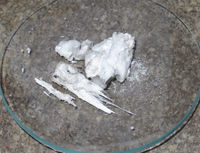Difference between revisions of "Boron trioxide"
(I will add the properties later I don´t have enough time right now.) |
m |
||
| Line 52: | Line 52: | ||
| Section2 = {{Chembox Properties | | Section2 = {{Chembox Properties | ||
| AtmosphericOHRateConstant = | | AtmosphericOHRateConstant = | ||
| − | | Appearance = | + | | Appearance =Hard glassy solid or white powder. |
| − | | BoilingPt = | + | | BoilingPt = 1,860 °C (3,380 °F; 2,130 K) |
| BoilingPtC = | | BoilingPtC = | ||
| BoilingPt_ref = | | BoilingPt_ref = | ||
| Line 62: | Line 62: | ||
| LogP = | | LogP = | ||
| MolarMass = | | MolarMass = | ||
| − | | MeltingPt = | + | | MeltingPt = 450 °C (842 °F; 723 K) |
| MeltingPtC = | | MeltingPtC = | ||
| MeltingPt_ref = | | MeltingPt_ref = | ||
| Line 69: | Line 69: | ||
| pKb = | | pKb = | ||
| Solubility = | | Solubility = | ||
| − | | SolubleOther = | + | | SolubleOther = methanol |
| Solvent = | | Solvent = | ||
| VaporPressure = | | VaporPressure = | ||
Revision as of 17:37, 8 February 2016

| |
| Names | |
|---|---|
| IUPAC name
Boron trioxide
| |
| Properties | |
| Appearance | Hard glassy solid or white powder. |
| Melting point | 450 °C (842 °F; 723 K) |
| Boiling point | 1,860 °C (3,380 °F; 2,130 K) |
| Solubility | methanol |
| Except where otherwise noted, data are given for materials in their standard state (at 25 °C [77 °F], 100 kPa). | |
| Infobox references | |
Boron trioxide is a glass like solid or white powder with the chemical formula B2O3.
Contents
Properties
Chemical
Boron trioxide is very unreactive. It can however be reduced to elemental boron with magnesium or aluminum powder in a thermite reaction.
Physical
When produced from boric acid, it forms as a non crystaline mass that is very hard and difficuilt to grind, forming a very fine powder when ground very similar to a solid plane of glass.
Availability
It is used in glassmaking, whether as a boron additive for making borosilicate glass or as a fluxing agent so this may be a source, however it is easy to produce from the starting materials boric acid or borax.
Preparation
Boric acid can be dehydrated above 300 degrees to form boron trioxide. Boron trioxide does not reabsorb this water from the atmosphere so is stable at room temperature.
Projects
- Producing boron
- Making the ester trimethyl borate